|
ARCHAEOLOGY TOUR
Discoveries at the site I: The Temple City of Ayodhya
Until recently, much of the evidence was literary, based
on accounts in chronicles, supplemented by some archaeology
around the site. Even then, archaeology left little doubt
regarding the existence of a previous temple at the site
at which the Babri Masjid is situated. Ayodhya has drawn
the attention of competent archaeologists including a
few internationally known experts like B.B. Lal and S.P.
Gupta.
As a result, the volume of data available is huge running
into several volumes. Some of it has probably been rendered
obsolete by discoveries following the demolition of December
6, 1992. They settle once and for all the question: Was
there a Hindu temple at the site before Babri Masjid was
built in 1528?
Let us next look at what archaeology has to say about
the Ayodhya site. The first point to note is that Ayodhya
lies in a region that is generously watered, and has therefore
been densely populated since time immemorial.
As a result, archaeological work at Ayodhya is more difficult,
and has not been on the same scale as at Harappan sites
lying a thousand miles to the west. And for the same reasons,
luck plays a large role in the success of any exploration
at Ayodhya, which is true of archaeology in general. Here
is what a leading archaeologist, Dr. S.P. Gupta (former
director of the Allahabad Museum), has to say about recent
excavations at Ayodhya. Gupta probably has the most extensive
experience among the archaeologists to have explored the
site.
From 1975 through 1980, the Archaeological Survey of
India under the Directorship of Professor B.B. Lal, a
former Director General of the Survey, undertook an extensive
programme of excavation at Ayodhya, including the very
mound of the Ramajanmabhumi on which the so-called "Janmasthan
Masjid" or Babri Mosque once stood and was later
demolished on 6th December 1992.
This is an interesting observation: the Babri Mosque
was known also as the 'Janmashtan Masjid' even to the
Muslims! Obviously they believed it to be the birthplace
of Rama — not Babar. We shall see later that until
the Secularists showed them the value of it, the Muslims
never used Negationism; far from it, they took great pride
in their record of vandalization of Hindu sacred places.
To continue with Gupta's account:
At Ayodhya, Professor Lal took as many as 14 trenches
at different places to ascertain the antiquity of the
site. It was then found that the history of the township
was at least three thousand years old, if not more ...
. When seen in the light of 20 black stone pillars, 16
of which were found re-used and standing in position as
corner stones of piers for the disputed domed structure
of the 'mosque', Prof. Lal felt that the pillar bases
may have belonged to a Hindu temple built on archaeological
levels formed prior to 13th century AD ...
On further stratigraphic and other evidence, Lal concluded
that the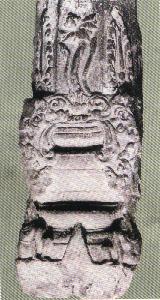 pillar bases must have belonged to a Hindu temple that
stood between 12th and the 16th centuries. "He also
found a door-jamb carved with Hindu icons and decorative
motifs of yakshas, yakshis, kirtimukhas, purnaghattas,
double lotus flowers etc."
pillar bases must have belonged to a Hindu temple that
stood between 12th and the 16th centuries. "He also
found a door-jamb carved with Hindu icons and decorative
motifs of yakshas, yakshis, kirtimukhas, purnaghattas,
double lotus flowers etc."
Pillar bases found at the site of the 'mosque'
What this means is that Lal had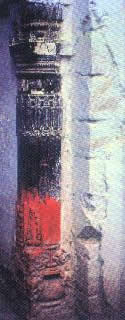 found evidence for possibly two temples, one that existed
before the 13th century, and another between the 13th
and the 16th centuries.
found evidence for possibly two temples, one that existed
before the 13th century, and another between the 13th
and the 16th centuries.
This corresponds very well indeed with history and tradition.
We know that this area was ravaged by Muslim invaders
following Muhammad of Ghor's defeat of Prithviraj Chauhan
in the second battle of Tarain in 1192 AD. This was apparently
rebuilt and remained in use until destroyed again in the
16th century by Babar.
Impressive as these discoveries are, Lal had actually
been somewhat unlucky. He had barely missed striking a
trench containing a treasure trove of Hindu artifacts
from the medieval period. As Gupta tells us:
Prof. Lal had hard luck at Ramajanmabhumi. His southern
trenches missed a huge pit with 40 and odd sculptures
just by 10 to 12 feet. But he did get the pillar bases
of the pre-16th century demolished-temple which others
did not get.
Excavation was resumed on July 2, 1992 by S.P. Gupta,
Y.D. Sharma, K.M. Srivastava and other senior archaeologists.
This was less than six months before the demolition (which
of course no one then knew was going to take place). Their
particular interest lay in the forty-odd Hindu artifacts
that had been discovered in the pit missed by Lal. These
finds had been widely reported in the newspapers. Gupta,
a former Director of the Allahabad Museum and an expert
on medieval artifacts had a special interest in examining
the finds. He tells us:
The team found that the objects were datable to the
period ranging from the 10th through the 12th century
AD, i.e., the period of the late Pratiharas and early
Gahadvals. The kings of these two dynasties hailing from
Kannauj had ruled over Avadh and eastern Uttar Pradesh
successively during that period.
These objects included a number of amakalas, i.e., the
cogged-wheel type architectural element which crown the
bhumi shikharas or spires of subsidiary shrines, as well
as the top of the spire or the main shikhara ... This
is a characteristic feature of all north Indian temples
of the early medieval period and no one can miss it —
it is there in the Orissa temples such as Konarak, in
the temples of Madhya Pradesh such as Khajuraho and in
the temples of Rajasthan such as Osian.
There was other evidence — of cornices, pillar
capitals, mouldings, door jambs with floral patterns and
others — leaving little doubt regarding the existence
of a 10th - 12th century temple complex at the site of
Ayodhya. So Lal had been right in believing there was
an earlier temple — prior to the one destroyed by
Babar. More discoveries were made following the demolition
of December 6. All these discoveries leave no doubt at
all about the true picture.
The discovery of a number of Kushana period terracotta
images of gods and goddesses earlier made it clear, first,
that at the Janmabhumi site Hindu temples were built several
times during the 2000 years with the interval of only
450 years, from 1528 to 1992, when the Muslims destroyed
the temple and occupied the site and also built a new
structure they called 'Janmabhumi Masjid' in their own
record; ... (See below.)
And finally, the temple was destroyed sometime after
the 13th century AD, in every likelihood in the early
16th century, as is fully borne out by the inscriptions
of Mir Baqi found fixed in the disputed structure from
back in time, during the British days as is clear from
the accounts given by Mrs. A. Beveridge in her translation
of Babur-Nama published in 1926.
Kushana period artifacts from the 'mosque' site
So archaeology also leaves little doubt about the existence
of theprior temple. Then came the explosion of Decembr
6, 1992.
On Top of the Page
|
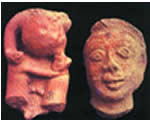 This
demolished not only the Babri Masjid but the whole case
of the Secularists and their allies. It revealed a major
inscription that settles the question once and for all. This
demolished not only the Babri Masjid but the whole case
of the Secularists and their allies. It revealed a major
inscription that settles the question once and for all.
Discoveries at the site II: the Hari-Vishnu inscription
The demolition on December 6, 1992 changed the picture
dramatically, providing further support to the traditional
accounts — both Hindu and Muslim. Some of the kar-sevaks,
no doubt influenced by all the publicity about history
and archaeology, went on to pick up more than two hundred
pieces of stone slabs with writing upon them. These proved
to belong to extremely important inscriptions, more than
a thousand years old. In effect, the kar-sevaks had done
what archaeologists should have done years ago; they had
unearthed important inscriptions — in howsoever a
crude form — something that should have been done
years ago by professional historians and archaeologists.
The inscriptions, even the few that have been read so
far, shed a great deal of light on the history of not
only Ayodhya and its environs, but all of North India
in the early Medieval, and even the late ancient period.
In any other society, these inscriptions and other archaeological
artifacts would not only be greeted with glee — as
Biblical scholars did the Dead Sea Scrolls — but
there would also be a mad scramble among researchers to
see what new discoveries they could make. But the Secularists'
reaction was the exact opposite of this: they wanted the
whole thing suppressed. They claimed, without examination,
that all the two-hundred and fifty odd pieces of epigraphical
records were forgeries planted during the demolition,
and demanded a police investigation. This is a point worth
noting: they wanted not an investigation of artifacts
by scholars, but a police investigation.
To return to the inscriptional finds, it will be years
before scholars can come up with a complete picture, but
they have already yielded much valuable information. Here
is what S.P. Gupta found upon examining the two-hundred
and fifty or so stone pieces with writing upon them:
Not all were ancient, since scores of them, generally
rectangular marble tiles, bore the dedicatory inscriptions
in the Devanagari script of the 20th century. However,
at least three dozens of them were certainly ancient,
belonging to the period bracketed between 10th and 12th
centuries AD. (In The Ayodhya Reference: pp 117-18)
The most important of these deciphered so far is the
Hari-Vishnu inscription that clinches the whole issue
of the temple. It is written in 12th century AD Devanagari
script and belongs therefore to the period before the
onslaught of the Ghorids (1192 AD and later). Gupta tells
us:
This inscription, running in as many as 20 lines, is
found engraved on a 5 ft. long, 2 ft. broad and 2.5 inches
thick slab of buff sandstone, apparently a very heavy
tablet ... Three-fourths of the tablet is found obliterated
anciently. The last line is also not complete since it
was anciently subjected to chipping off. A portion of
the central part is found battered, maybe someone tried
to deface it anciently.The patination [tarnishingincluding
wearout] is, however, uniform all over the surface, even
in areas where once there were inscriptions. (op. cit.
pp 118-19)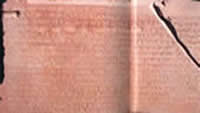
The 12 century 'Hari-Vishnu' inscription found at the
'mosque site'
Gupta is an archaeologist and not an epigraphist trained
to read ancient inscriptions. It was examined by Ajay
Mitra Shastri, Chairman of the Epigraphical Society of
India. Shastri gave the following summary. What the inscription
tells us is of monumental significance to the history
of Medieval India.
The inscription is composed in high-flown Sanskrit verse,
except for a very small portion in prose, and is engraved
in chaste and classical Nagari script of the eleventh-twelfth
century AD. It has yet to be fully deciphered, but the
portions which have been fully deciphered and read are
of great historical significance and value ... [It has
since been fully deciphered.]
It was evidently put up on the wall of the temple, the
construction of which is recorded in the text inscribed
on it. Line 15 of this inscription, for example, clearly
tells us that a beautiful temple of Vishnu-Hari, built
with heaps of stones ... , and beautified with a golden
spire ... unparalleled by any other temple built by earlier
kings ... This wonderful temple ... was built in the temple-city
of Ayodhya situated in Saketamandala. ... Line 19 describes
god Vishnu as destroying king Bali ... and the ten headed
personage (Dashanana, i.e., Ravana). (op. cit. 119; emphasis
mine. Original Sanskrit quotes given by Shastri are left
out.)
Need we say more — a temple for Hari-Vishnu who
killed the ten-headed Ravana, in the temple city of Ayodhya?
So Ayodhya was known as a temple city even then; Saketa
was the ancient name of the district. The inscription
confirms what archaeologists Lal and Gupta had earlier
found about the existence of a temple complex. And yet
the Secularists and their allies have been telling the
world that there was no temple! 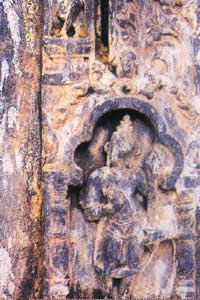
Part of dwara-palaka (gate keeper) found at the 'mosque'
site
Summary of findings
We may now sum up the findings based on both literary
and archaeological/epigraphic evidence:
1 All the literary sources without exception, until the
Secularists began their negationist masquerade, are unanimous
that a Rama temple existed at the site known since time
immemorial as Rama Janmabhumi.
2. Archaeology confirms the existence of temples going
back to Kushan times, or about 2000 years. This date may
well be extended by future excavations assuming that such
excavations will be permitted by politicians.
3. Archaeology records at least two destructions: the
first in the 12th-13th century; the second, later, in
all probability in the 16th. This agrees well with history
and tradition that were temple destructions following
the Ghorid invasions (after 1192 AD) and restored, and
was destroyed again in 1528 by Babar who replaced it with
a mosque. This is the famous — or infamous —
Babri Masjid that was demolished by kar-sevaks on December
6, 1992.
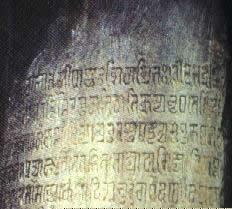
Another 12th century inscription found at the 'mosque'
site
4. A large inscription discovered at the site dating
to 11th-12th century records the existence of numerous
temples including a magnificent one in which Hari-Vishnu
was honored as destroyer of the ten-headed Ravana. Ayodhya
was always known as a temple city.
These facts drawing upon several literary and archaeological
sources leave no doubt at all that a temple located at
a site sacred to the Hindus was destroyed to build a mosque
under Babar’s express orders.
|